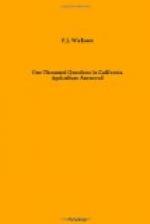You ought to be able to get 10 tons of silage per acre from corn grown on good corn land. It can be best grown in rows sufficiently distant for cultivation, closer in the row than would be desirable for corn, and yet not too crowded, because corn for silage should develop good ears and should be cut for silage about the time when the glazing begins to appear. If your land needs fertilization, stable manure or a “complete fertilizer” of the dealers would be the proper thing to use. It would be very desirable to plow corn land deeply the preceding fall, followed by a packer or harrow to settle down the land below, but do not work down fine. Keep the surface stirred from time to time during the winter and put in the crop with the usual cultivation in the spring as soon as the frost danger is over.
Irrigation for Corn.
What amount of water is necessary per acre for the best possible yield of corn under acreage conditions and proper cultivation in the San Joaquin or Sacramento valleys?
No one can answer such a question with anything more than a guess. It depends upon how much rain has fallen the previous winter, how retentive the soil is naturally, and what has been done to help the soil to hold it. Nearly all the corn that is grown is carried without any irrigation at all on moist lowlands, which may be too wet for winter crops. If you demand a guess, make it six acre-inches, with a good surface pulverizing after each run of water in furrows between the rows. This water would be best used in two or three applications.
Eastern Seed Corn for California.
The question has been raised as to Eastern-grown seed corn, comparing it with California-grown seed. Some claim that the former does not yield well the first season.
We cannot give a complete refutation of the impression that Eastern seed corn does not yield well the first season in California. It is a somewhat prevalent impression. All that we can announce now is that we have grown collections of Eastern seed corn and have found the product quite as good as could have been expected, and did not encounter, apparently, the trouble of which you write.
Need of Corn Suckering.
To insure the best crop of corn possible, does it pay to sucker it or not?
The removal of suckers is a matter of local conditions largely in California, and growers are getting out of the habit of suckering. In some places suckering is needed, and in others it apparently does not pay to do so, although with very rare exceptions a larger yield can be secured by suckering than without.
Cow Peas Not Preparatory for Corn.
What time of the year can cow peas be planted, and can the entire crop be plowed under in time for planting field corn?
Cowpeas are very subject to frost. They are really beans, and therefore can be grown in the winter time only in a few practically frostless places. Wherever frosts are likely to occur they must be planted, like beans and corn, when the frost danger is over. Field peas, Canadian peas and vetches are hardy against frost and therefore safer for winter growth, and treated as you propose they may be preparatory for corn-growing providing you plow them under soon enough to get a month or more for decay before planting the corn.




